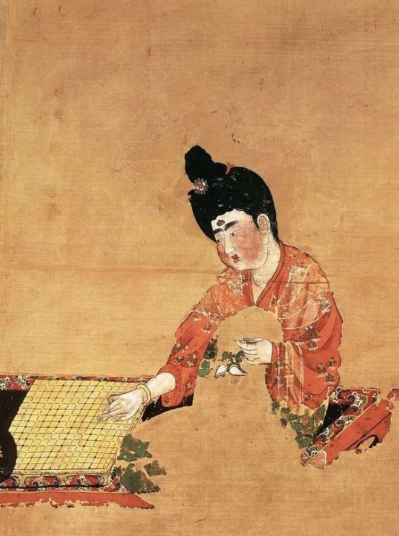| Xinjiang Today |
| Dialogue in pigment | |
|
|
 Beauty Playing Go, ink and color on silk, excavated from a tomb in Turpan in 1972 (FILE)
From elderly men playing Chinese chess on street corners to the inclusion of Go (weiqi) in the upcoming 15th National Games in November, evidence of the continued popularity of board games in China is abundant. But when searching for evidence of this popularity in ancient times, one cannot go past the game beautifully captured in the precious Tang Dynasty (618-907) silk painting Beauty Playing Go. Board games first appeared in China during the Shang Dynasty (1600-1046 B.C.). While liubo and shuanglu, which involved dice, were popular for entertainment at banquets, games like Chinese chess and Go were more highly valued by scholars and writers. These more strategic and confrontational games provided a way for intellectuals to sharpen their minds and cultivate their character during their leisure time. As Go grew in popularity, numerous manuals and strategic guides, such as The Classic of Go and The Principles of Go, were created to document its complexity. The painting and its story In 1972, a fragment of a silk painting was unearthed from a tomb in Turpan. After meticulous restoration, a scene of a noblewoman playing Go, accompanied by maids and children, was revealed. The painting is approximately 63 cm in height and 54 cm in width. It is currently housed in the Xinjiang Uygur Autonomous Region Museum. The noblewoman is the focal point, with her full figure, rosy complexion and graceful demeanor. With her index and middle fingers poised over a Go stone, she appears to be deep in thought. Her captivating presence is why the painting was named for her. The tomb forms part of the burial complex of the Zhang family, a wealthy and influential clan. The painting depicts the domestic life of typical noble households and was most likely created by a member of the Zhang family itself or a court painter in their employ, rather than by a common artisan. Playing Go was a favorite daily activity for Tang Dynasty aristocrats. The game was so popular that a Go attendant system was established in the Hanlin Academy, where professional players were hired to play with the emperor. The game's popularity extended far beyond the capital, eventually reaching the Western Regions and becoming a favored pastime for the noble people there. The central figure of the painting is meticulously detailed: Her high-piled bun is adorned with flowers, her eyebrows are shaped in the popular style of the time, and her face is full and plump, reflecting the Tang Dynasty's aesthetic ideal of beauty. Her attire—a blue-flowered blouse, a white silk shawl and a green floor-length skirt—suggests she was likely the wife of a sixth-rank official. The Tang Dynasty's nine-rank system was a hierarchical structure used to classify civil and military officials, with the first rank being the highest and the ninth being the lowest. The women in the painting are dressed in short jackets and long skirts, which were the standard daily attire for Tang women. In a fascinating detail, the maids wear men's long robes, a fashionable trend among the aristocracy at the time, as recorded in the Old Book of Tang: Treatise on Carriages and Clothes, a major historical work on the Tang Dynasty. The painting's style, with its strong, even lines and bright colors, not only reflects the fashion trends of the era but also embodies the artistic style of Tang Dynasty portraiture—curved eyebrows and full cheeks, where flesh triumphs over bone. A tapestry of exchange Beauty Playing Go, while discovered in a frontier region, depicts a scene of typical Central Plains life during the Tang Dynasty, offering evidence of the exchanges between China's regions in ancient times. Go, one of China's four ancient arts, flourished during the Tang Dynasty, especially under the promotion of Emperor Xuanzong (685-762). The painting confirms that the game's popularity had spread all the way to China's western frontier during that time. In 640 A.D., the Tang Dynasty established Xizhou as a new prefecture in Turpan. At that time, economic and cultural exchanges between the Central Plains and the Western Regions became much closer. This was a two-way street: While Central Plains fashion became popular in Xinjiang, the Central Plains were also deeply influenced by frontier cultures. The widespread influence of cultures from the Western Regions is collectively referred to as "hu" in Chinese. Various historical records note that even the highest echelons of society were captivated by "hu-style" customs, with nobles and commoners alike adopting hu-style clothes and hats. This cultural blend is visible in the very figures of the painting: While they are dressed in Han Chinese clothes, their hairstyles reflect the buns of the popular Western Regions style. This phenomenon is a direct result of the mutual learning and integration of the diverse cultures of ancient China. In essence, Beauty Playing Go is more than just a beautiful piece of art; it is a historical document. It stands as a powerful testament to the cultural exchange between Xinjiang and the Central Plains, showing how the cultures of various ethnic groups flourished together in the fertile soil of Chinese civilization during the Tang Dynasty. Comments to maxiaowen@cicgamericas.com |
|
||||||||||||||||||||||||||||
|